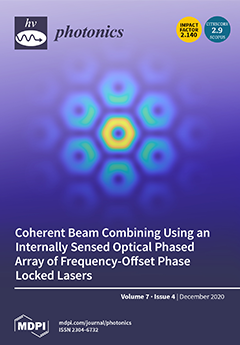The main problem of intensity modulation (IM) in radio-over-fiber (RoF) communication is dispersion power fading (DPF), which occurs when the signal is transmitted through a dispersive link that causes a sideband cancelation effect. The DPF level of the RoF link is determined by the deviation factor (DF). The optical single-sideband (OSSB) modulation scheme, which is generated by driving one of the dual-drive Mach–Zehnder modulators (DD-MZMs), is usually used to overcome DPF. The DF value of OSSB modulation at modulation index
m = 0.1 increases from 0.008 to 0.930 at
m = 1. It can be said that this method is only effective at reducing DF at low
m. However, as well-known information of the DD-MZM system, high-efficiency optic–electric conversions can be obtained at high
m values, but DF will increase. Therefore, reducing the DPF value for high
m ≥ 0.1 is interesting. It is known that in wireless communication, to reduce the impact of fading, direct signals are amplified and signals with irregular phases are used. Moreover, this paper proposes the DD-MZM with an asymmetric carrier divider as a direct signal and combines it with an irregular radio frequency (RF) phase to reduce the DPF at high
m. The carrier that is generated by laser diode (LD) power (P
IN) is divided asymmetrically as power modulation (P
DD-MZM) and carrier arm (CA) power (P
CA). Furthermore, the minimum DF is obtained when the P
IN is separated as 75% for P
CA and 25% for P
DD-MZM with an irregular RF signal of
θ = 48° and a bias point value of
γ = ¾. As a result, with the same power as OSSB, this proposed structure produces DF at
m = 0.1 and
m = 1 with values of 0.008 and 0.03, or it can reduce DF of 96.7% at
m = 1. The mathematical model and simulation model have very good agreement, which validates the proposed method.
Full article





